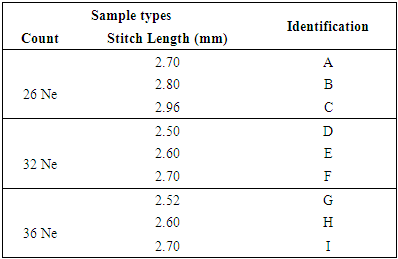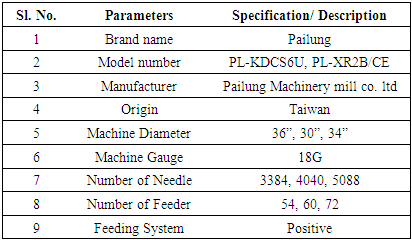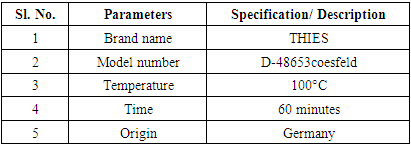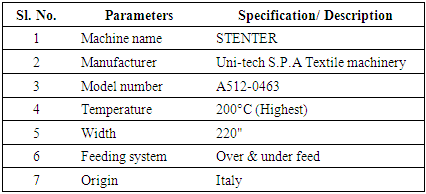-
Paper Information
- Paper Submission
-
Journal Information
- About This Journal
- Editorial Board
- Current Issue
- Archive
- Author Guidelines
- Contact Us
International Journal of Textile Science
p-ISSN: 2325-0119 e-ISSN: 2325-0100
2018; 7(4): 94-100
doi:10.5923/j.textile.20180704.03

Effect of Yarn Count & Stitch Length on the Fabric Width, GSM, WPI and CPI of 1×1 Rib Fabrics
Md. Reazuddin Repon1, 2, Md. Nura Alam Shiddique1, Debasree Paul1, Rajib Al Mamun1, Sumaiya Shahria1, Mohaiminul Quayum3
1Department of Textile Engineering, Khwaja Yunus Ali University, Sirajgonj, Bangladesh
2Department of Chemistry, Khulna University of Engineering and Technology, Khulna, Bangladesh
3Department of Textile Engineering, Mawlana Bhashani Science and Technology University, Tangail, Bangladesh
Correspondence to: Md. Reazuddin Repon, Department of Textile Engineering, Khwaja Yunus Ali University, Sirajgonj, Bangladesh.
| Email: |  |
Copyright © 2018 The Author(s). Published by Scientific & Academic Publishing.
This work is licensed under the Creative Commons Attribution International License (CC BY).
http://creativecommons.org/licenses/by/4.0/

The present study attempts to disclose the effect of yarn count and stitch length of 1×1 rib fabrics. 100% cotton knitted fabrics having different areal density were used in this experiment. The counts of the yarn used were 26Ne, 28 Ne and 36 Ne of different stitch length. The effects of yarn count and stitch length were calculated in terms of fabric width, areal density (GSM), Wales per inch (WPI) and course per inch (CPI) in different processing stages viz. dyeing and washing state and finished state. The results revealed that the fabric GSM, WPI and CPI increases with the increases of yarn count and stitch length in dyeing and washing state and finished state but opposite scenario observed in case of fabric width.
Keywords: Rib fabric, Yarn count, Stitch length, Areal density, Processing parameters, Fabric width
Cite this paper: Md. Reazuddin Repon, Md. Nura Alam Shiddique, Debasree Paul, Rajib Al Mamun, Sumaiya Shahria, Mohaiminul Quayum, Effect of Yarn Count & Stitch Length on the Fabric Width, GSM, WPI and CPI of 1×1 Rib Fabrics, International Journal of Textile Science, Vol. 7 No. 4, 2018, pp. 94-100. doi: 10.5923/j.textile.20180704.03.
Article Outline
1. Introduction
- Knitting is one of the fabric forming methods in which the series of yarn loops are intermeshed to produce the fabric. The principles of knitting is classified into two based on the direction of loop formation or knitting namely weft knitting and warp knitting. If the direction of knitting is horizontal one that is called weft knitting and vertical one that is called warp knitting [1-3].The knitted fabrics, in general, are more stretchable than the woven fabrics. The open structure of knitted fabrics also helps in moisture vapor transmission making it suitable for the sports garments. Besides, the knitted fabrics have more porosity than the woven fabrics. Therefore, knitted structures can trap more air resulting in lower thermal conductivity and higher thermal resistance [4, 5]. Rib has a vertical cord appearance because the face loop wales tend to move over and in front of the reverse loop wales. As the face loops show a reverse loop intermeshing on the other side, 1x 1 rib has the appearance of the technical face of plain fabric on both sides until stretched to reveal the reverse loop wales in between. 1 x 1 rib is production of by two sets of needles being alternately set or gated between each other. Relaxed 1 x 1 rib is theoretically twice the thickness and half the width of an equivalent plain fabric, but it has twice as much width-wise recoverable stretch [1]. In practice, 1 x 1 rib normally relaxes by approximately 30 per cent compared with its knitting width. 1 x 1 rib is balanced by alternate wales of face loops on each side; it therefore lies flat without curl when cut. It is a more expensive fabric to produce than plain and is a heavier structure; the rib machine also requires finer yarn than a similar gauge plain machine. Like all weft-knitted fabrics, it can be unroved from the end knitted last by drawing the free loop heads through to the back of each stitch [6].Although knitted rib structures are widely used in body lengths for outerwear, their main use is in providing welts, cuffs, and collars for garments with plain-knitted bodies and sleeves. Two properties of 1 x 1 rib fabric make it particularly suitable for these trimmings. Firstly fabrics of this type are free from edge-curling, such as occurs in plain fabrics, and secondly they are readily extended in width and show immediate and almost complete recovery from extension during wear [7, 8].The impact of different knit constructions on dimensional and physical properties has been reported by many researchers [9-12]. Influence of various parameters such as yarn count, twist, stitch length, tightness factor, finishing process and washing on the dimensional properties of knitted fabric have been investigated by many researchers [4, 13-21].The goal of this study was to find the effect of yarn count and stitch length on fabric width, areal density (GSM), Wales per inch (WPI) and course per inch (CPI) of the 1×1 rib fabrics in different processing stages viz. dyeing and washing state and finished state.
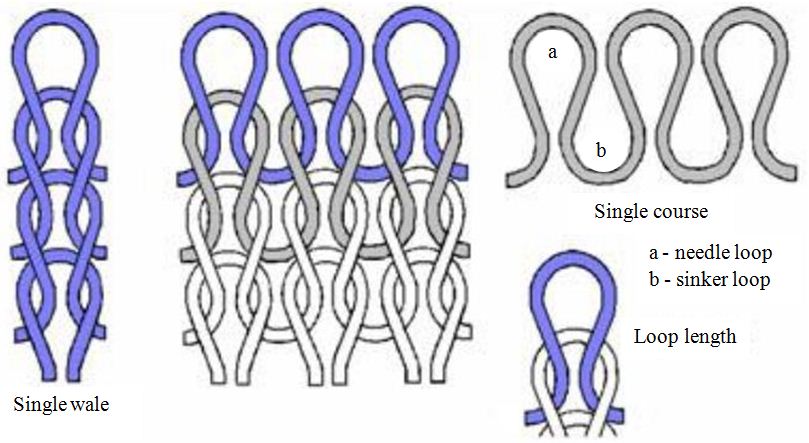 | Figure 1. Elements of knitted structure [23] |
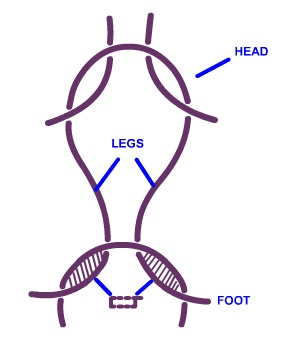 | Figure 2. A knitted loop [22] |
 | Figure 3. Stitch density of knitted fabric [23] |
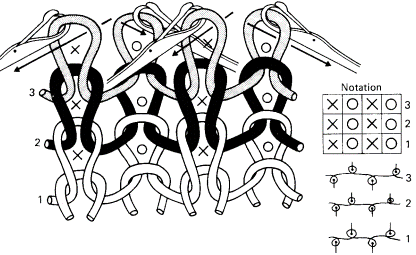 | Figure 4. 1×1 Rib structure [1] |
2. Experimental
2.1. Materials and Methods
2.1.1. Materials
- 100% cotton knitted 1×1 rib fabrics having different areal density were used in this experiment. Fabrics were collected from “DIVINE GROUP LIMITED”, kaliakoir, Gazipur, Bangladesh. The fabric has a variety of geometrical properties like count, course per inch (CPI), Wales per inch (WPI) and stitch length.
2.2. Methods
2.2.1. Sampling
2.2.2. Sample Testing
- The tests of the samples were carried out after conditioning at 27°C± 2°C & 65% RH.
2.2.2.1. Determination of Fabric Width
- Width of the tubular fabric was measured using measuring tape.
2.2.2.2. Determination of Stitch Length
- HATRA Course Length Tester (SDL Atlas, England) were used for measuring stitch length.
2.2.2.3. Determination of Fabric Weight (GSM)
- After relaxation & conditioning of knit fabric samples, GSM of samples were measured by using GSM cutter (James Heal, England) and weighing balance [24].
2.2.2.4. Determination of WPI and CPI
- With the help of counting glass, WPI & CPI of fabrics with various stitch length were measured [25].
|
|
|
3. Results and Discussion
3.1. Fabric Width
- Figure 5 depicts the effect of yarn count and stitch length on fabric width in tubular form at different processing stages. It is clearly evident from the figure 5 that with the increasing of the yarn count and stitch length, the fabric width was decreased in dyeing and washing state and finished state. For the sample A, the width was decreased as 13.64% at dyeing and washing state but no change in finished state. The width of the sample B, C and D were decreased 13.24%, 10.06% and 22.5% at dyeing and washing state and opposite scenario has found in finished state, i.e, 3.39% increased for both for B and C and 1.61% increased for D. For the samples E, F, G, H and I, the widths were decreased as 16.67%, 16.46%, 6.63%, 10% and 5.06% at dyeing and washing state compared to grey state and 1.54%, 1.52%, 5.26%, 5.56% and 6.67% decreased accordingly at finished state compared to dyeing and washing state. It is also clearly marked from the figure 5 that with the increasing of the yarn count, the fabric width was decreased in dyeing and washing state and finished state compared to grey state when stitch length was fixed to 2.70 mm.
 | Figure 5. Effect of count and stitch length on fabric width |
3.2. Fabric GSM
- Figure 6 illustrates the effect of yarn count and stitch length on fabric weight normally termed as GSM at different processing stages. It is clearly evident from the figure 6 that with the increasing of the yarn count and stitch length, the fabric GSM also increased in dyeing and washing state and finished state compared to grey state. The GSM were increased as 20.19%, 19.23%, 10.29%, 14.71%, 15.43%, 16.99%, 26.72%, 26.77% and 13.93% for the samples of A, B, C, D, E, F, G, H and I respectively at dyeing and washing state compared to grey state. Conversely, the GSM were decreased as 6.64%, 2.02%, 3.08%, 1.07%, 5.59% for the samples A, B, D, E and F correspondingly but 2.22%, 4.22%, 4.35%, 7.91% decreased for the samples C, G, H and I at finished state compared to dyeing and washing state. It is also obviously noticeable from the figure 6 that with the increasing of the yarn count, the fabric GSM also increased in dyeing and washing state and finished state compared to grey state when stitch length was fixed to 2.70 mm.
 | Figure 6. Effect of count and stitch length on fabric GSM |
3.3. Wales Per Inch (WPI)
- Figure 7 demonstrates the effect of yarn count and stitch length on fabric Wales per inch normally expressed as WPI at different processing stages. It is clearly evident from the figure 7 that the yarn count and stitch length has both positive and negative effect on WPI in dyeing and washing state and finished state also. The WPI of the samples A, B, C, D, E and F were increased as 7.41%, 20%, 7.41%, 7.69%, 16% and 16.67% accordingly and 16%, 3.85% and 12% were decreased for the samples of G, H and I at dyeing and washing state compared to grey state. On the other hand, the WPI were decreased 6.89%, 6.67% and 3.45% for the samples A, B and C and 7.14%, 3.45%, 3.57%, 33.33%, 24% and 36.36% were increased for the samples of D, E, F, G, H and I at finished state compared to dyeing and washing state. It is also clearly visible from the figure 7 that with the increasing of the yarn count, the WPI of the fabric increased in dyeing and washing state and finished state for the sample F but decreased in dyeing and washing state for the sample I compared to grey state when stitch length was fixed to 2.70 mm.
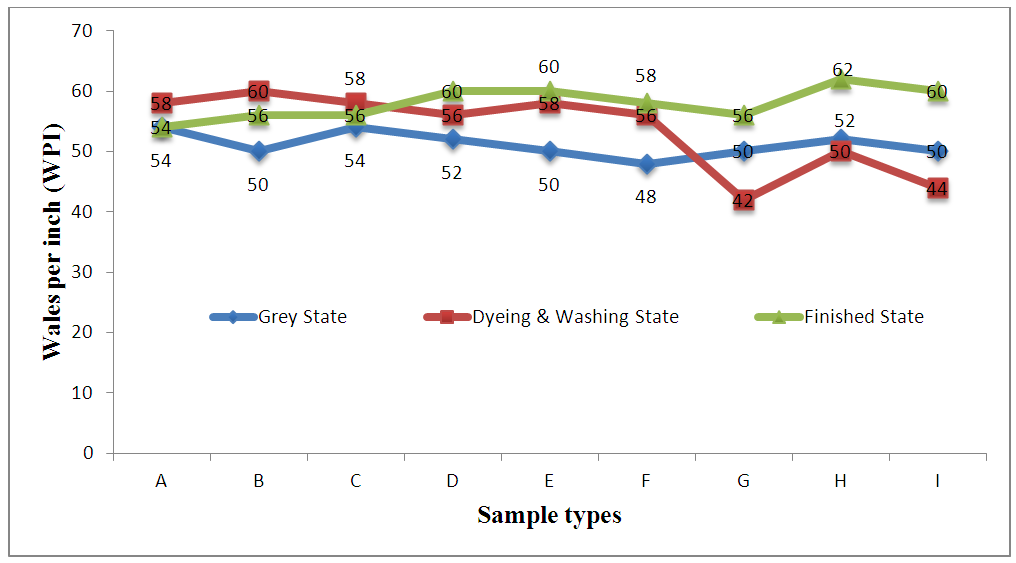 | Figure 7. Effect of count and stitch length on WPI |
3.4. Courses Per Inch (CPI)
- Figure 8 represents the effect of yarn count and stitch length on fabric courses per inch normally expressed as CPI at different processing stages. It is clearly evident from the figure 8 that with the increasing of the yarn count and stitch length, the fabric CPI also increased in dyeing and washing state and finished state compared to grey state. The CPI were increased as 42.86%, 7.14%, 10.53%, 10.64, 13.18%, 47.62%, 21.95% and 22.5% accordingly for the samples A, B, C, D, F, G, H and I at dyeing and washing state compared to grey state. On the other hand, the CPI were decreased 23.33%, 10.64%, 25.81%, 16% and 18.37% for the samples A, D, G, H and I and 2.22% both for B and E and 2.33% for the sample F were increased at finished state compared to dyeing and washing state. Interestingly, no change of CPI for the E at dyeing and washing state compared to grey state and for the sample C at finished state compared to dyeing and washing state. It is also clearly visible from the figure 8 that with the increasing of the yarn count, the CPI of the fabric increased in dyeing and washing state and finished state for the sample F and I compared to grey state when stitch length was fixed to 2.70 mm.
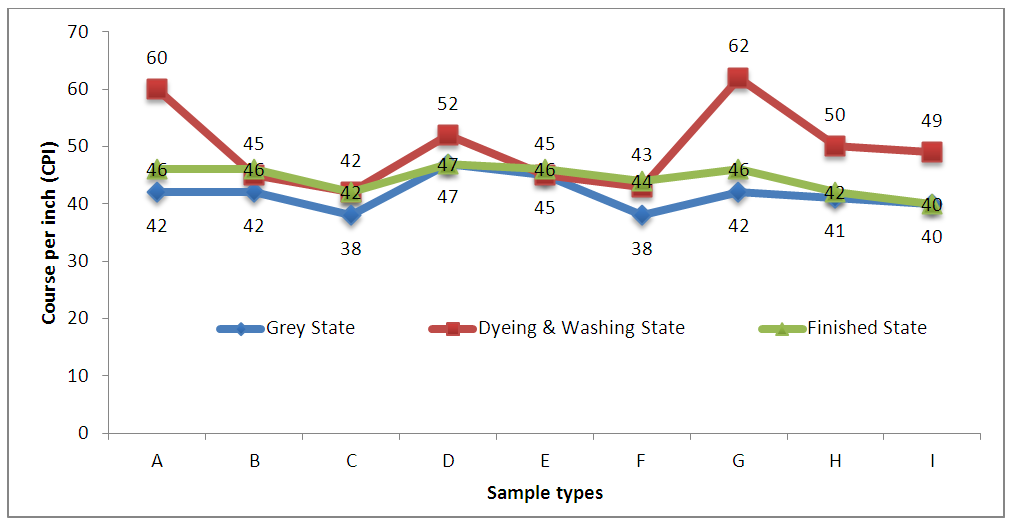 | Figure 8. Effect of count and stitch length on CPI |
4. Conclusions
- Count and stitch length are very essential parameters which control the different properties of weft knitted fabric. This study unveiled the effect of yarn count and stitch length on fabric width, areal density (GSM), Wales per inch (WPI) and course per inch (CPI) of the 1×1 rib fabrics in different processing stages viz. dyeing and washing state and finished state. Form the above mentioned data it has been identified that when stitch length and count increases then the fabric width decreases in dyeing and washing state and finished state. Here yarn count and stitch length both are variables. From the analysis, it also clear evident that the fabric GSM, WPI and CPI increases with the increases of yarn count and stitch length in dyeing and washing state and finished state.
 Abstract
Abstract Reference
Reference Full-Text PDF
Full-Text PDF Full-text HTML
Full-text HTML